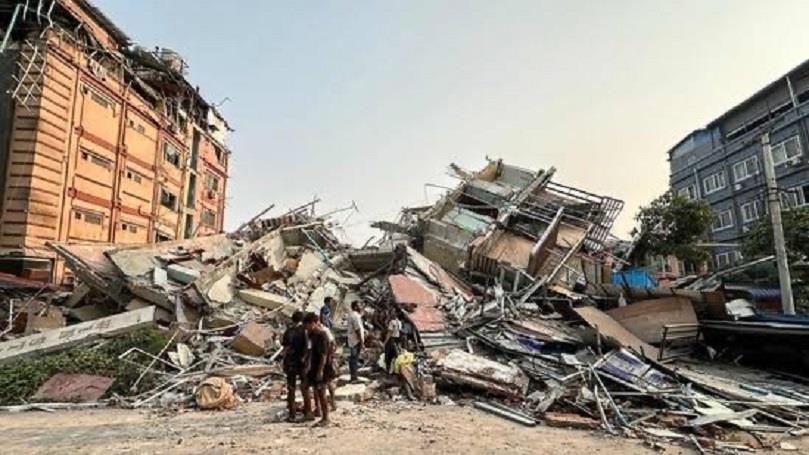
The Tectonic Link
What Myanmar's Earthquake Teaches Kashmir
On March 28, 2025, life changed dramatically for the people of Mandalay; at 12:50 PM local time, the ground beneath Myanmar's second-largest city shook violently. A powerful magnitude 7.7 earthquake tore through a 200-kilometer stretch of the Sagaing Fault. In less than ninety seconds, buildings crumbled, roads split open, and panic spread like wildfire. Just eleven minutes later, a magnitude 6.4 aftershock jolted the region again, adding to the devastation. This devastation is related to the tectonic story of this region, which connects most regions in South and Southeast Asia to one another. The northward motion of the Indian Plate continues to build strain at the plate margins where it interacts with the Eurasian Plate. Kashmir is part of this convergence belt, which is why we are directly connected to this devastation and must learn from it. While smaller aftershocks have continued since, this event serves as a grim reminder of the power earthquakes wield - and the lessons they carry for other regions, especially Kashmir.
The scale of devastation witnessed in Myanmar is not unfolding yet because of the non-openness of the current administration. And our estimates suggest that the hazards have turned into disasters because the ground was not prepared for the incoming devastation, which is painful and reminds us that similar devastation can recur in Kashmir like in the 2005 Muzaffarabad earthquake where we lost over 80,000 lives.
The Sagaing Fault is a major right-lateral strike-slip fault that slices through Myanmar and extends into the Andaman Sea. With a displacement rate of 18 mm per year, it's a ticking time bomb. Historically, this fault has been responsible for at least six powerful earthquakes - all magnitude 7 or greater - between 1930 and 1956. These events claimed hundreds of lives, triggered landslides, and left cities in ruin. Though Myanmar has experienced relative seismic calm in recent decades, the recent earthquake reminds us that silence along a fault does not mean safety - it may simply mean stress is quietly building beneath the surface.
Kashmir faces a strikingly similar threat. The northeastern margin of the Indian Plate is colliding with the Eurasian Plate, forming the towering Himalayas. This immense geological force is not just responsible for breathtaking peaks - it fuels a network of active faults, each capable of unleashing catastrophic earthquakes.
The tragedy in Myanmar underscores an urgent truth: regions like Kashmir must prepare for future earthquakes by addressing both structural integrity and engineering advancements. Active faults beneath our feet are constantly accumulating strain, and when this energy is released, only well-prepared societies can minimize the devastation. Building a seismic-resilient society demands a multi-faceted approach that combines robust infrastructure, innovative engineering solutions, and informed public readiness.
Read Also Myanmar's Earthquake Death Toll Jumps To Over 1,000 As More Bodies Recovered From Rubble Shallow Earthquake Jolts NCR; PM Modi Says Stay Calm, Alert For Possible AftershocksFor Kashmir, Myanmar's experience must serve as a stark reminder that proactive measures are essential. Strengthening infrastructure requires enforcing stricter building codes that mandate earthquake-resistant designs. Critical structures such as schools, hospitals, and emergency response centers must be constructed or retrofitted using advanced engineering techniques like base isolation, flexible foundations, and energy-absorbing materials. Bridges, dams, and transportation networks must be evaluated and reinforced to ensure they remain functional in the aftermath of strong tremors.
Equally important is improving emergency preparedness and raising public awareness. Communities must be educated on evacuation protocols, safe shelter practices, and basic first aid to respond swiftly and effectively when the earth shakes. Emergency services must be equipped with rapid response plans to minimize casualties and deliver aid efficiently.
The earth's restless forces do not recognize borders, and Myanmar's heartbreak today could easily become Kashmir's tragedy tomorrow. By investing in resilient infrastructure, embracing advanced engineering solutions, and fostering a culture of preparedness, we can transform disaster risk into survival - and safeguard lives in the face of inevitable seismic events.
- Views expressed in the article are the author's own and do not necessarily represent the editorial stance of Kashmir Observer

Legal Disclaimer:
MENAFN provides the information “as is” without warranty of any kind. We do not accept any responsibility or liability for the accuracy, content, images, videos, licenses, completeness, legality, or reliability of the information contained in this article. If you have any complaints or copyright issues related to this article, kindly contact the provider above.






















Comments
No comment